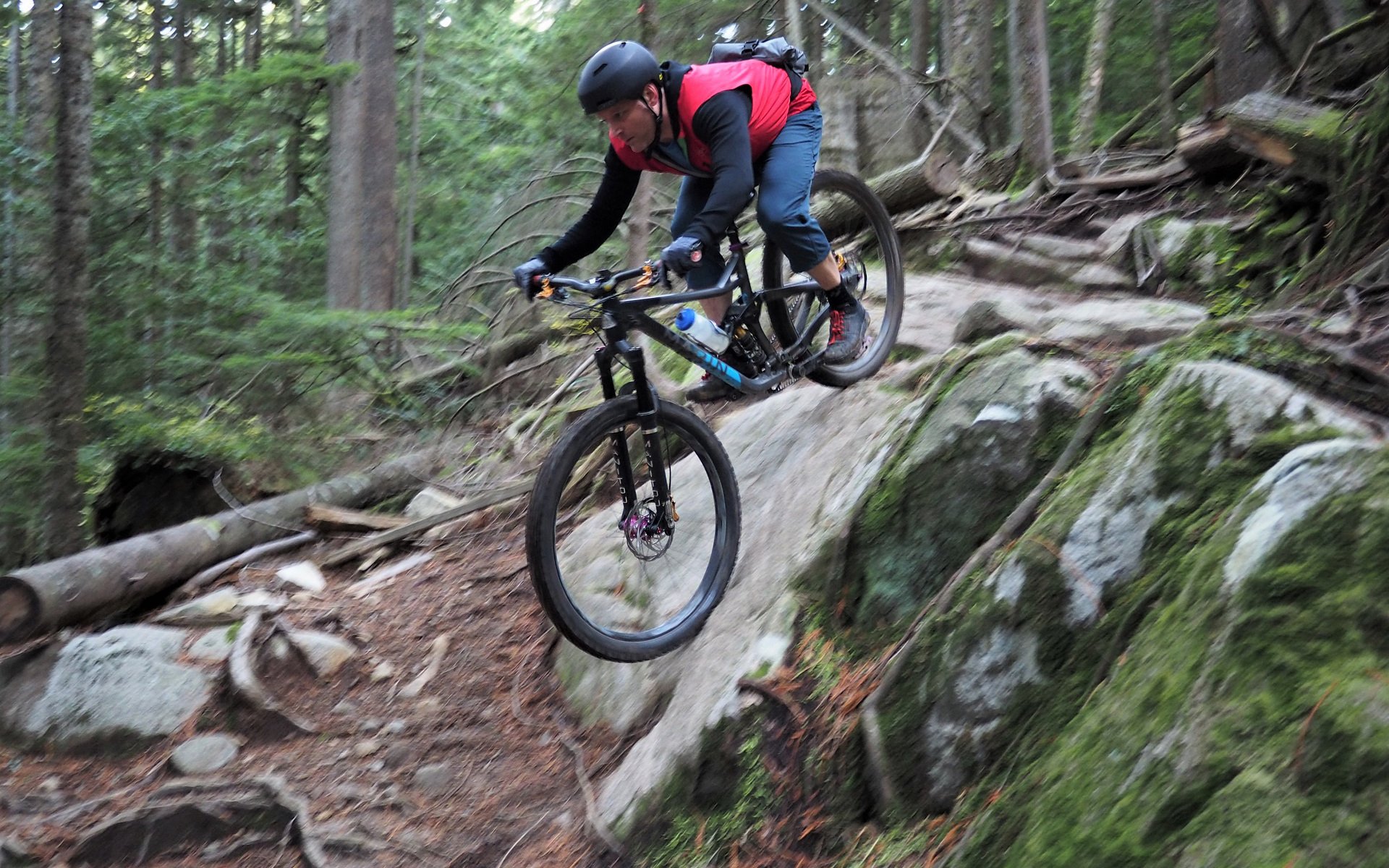
REVIEW | EDITORIAL
Riding Tall With The Manitou Mezzer Pro IRT Fork
Riding Tall
In 2020, and for the foreseeable future, consumers of mountain bike media will ingest a thousand takes on the amazing new idea that forks should ride high in their travel. Bikes will corner vastly better, fewer pedals shall be smacked on rocks as static bottom bracket heights sit higher, and riders will roll more confidently into steep descents.
Anyone who's pushed a World Cup-level racer's fork - DH, Enduro, or XC, will shrug. No kidding. Suspension tuners will glance nervously at each other now that the less-sag secret is out. Riders who purchased a rebound check valve update for their Fox Float fork in 2014 already understand the difference support makes as do any Clydesdales, or above-their-weight-class smashers, who've thrown down cash for custom valving.
Somewhere at Hayes Bicycle Components, I imagine there's a Manitou suspension engineer, crying into their coffee mug and a whole marketing department in hiding. Because, as great as all these latest-generation forks are, there is one, tunable, system that stands taller than all the rest; Manitou's IRT, Infinite Rate Tune, which has been out for years.
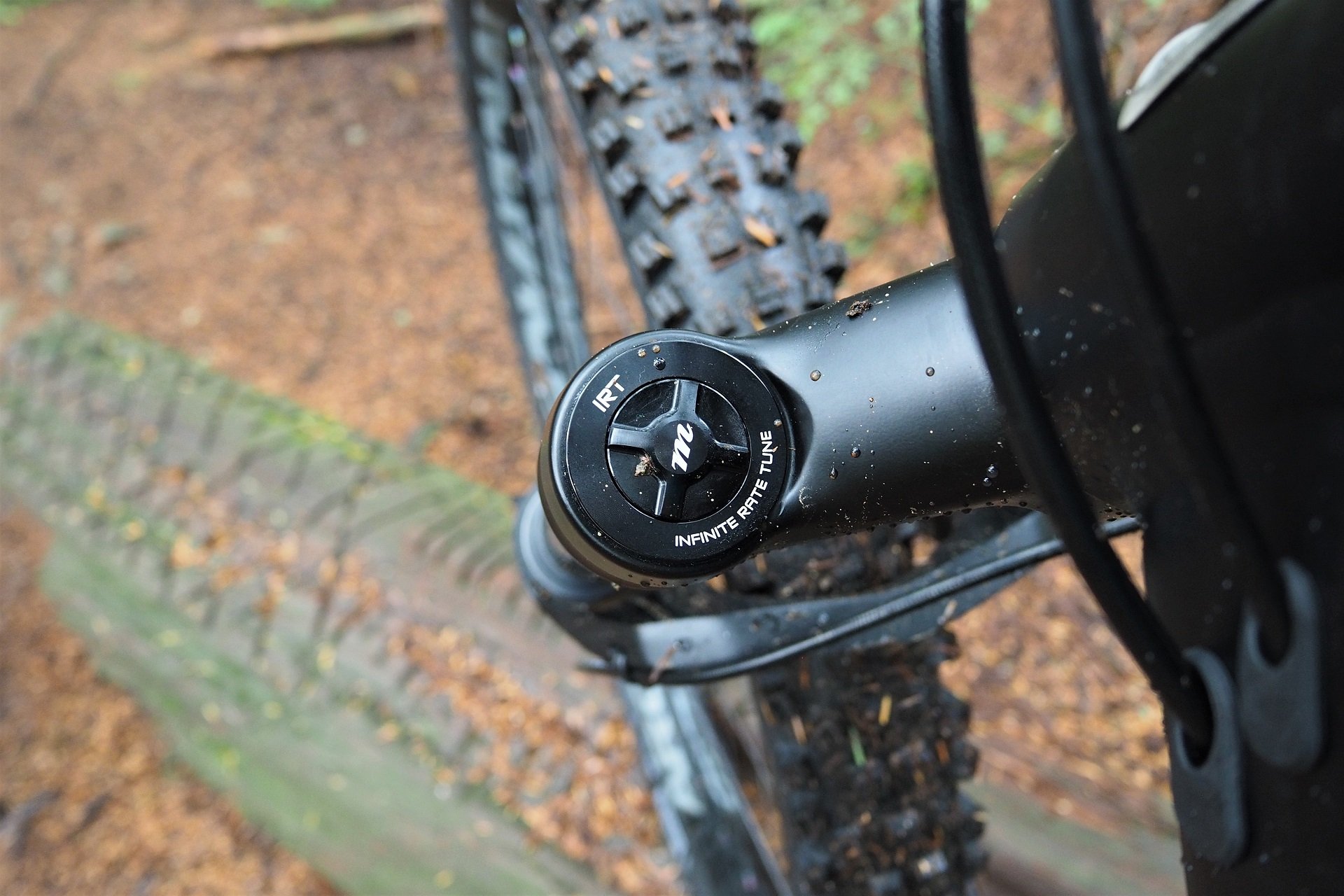
I've ridden Manitou's IRT air system in the Mezzer as well as their Mattoc Pro. It can be easily tuned to ride high into the steeps or to sit deeper into its travel.
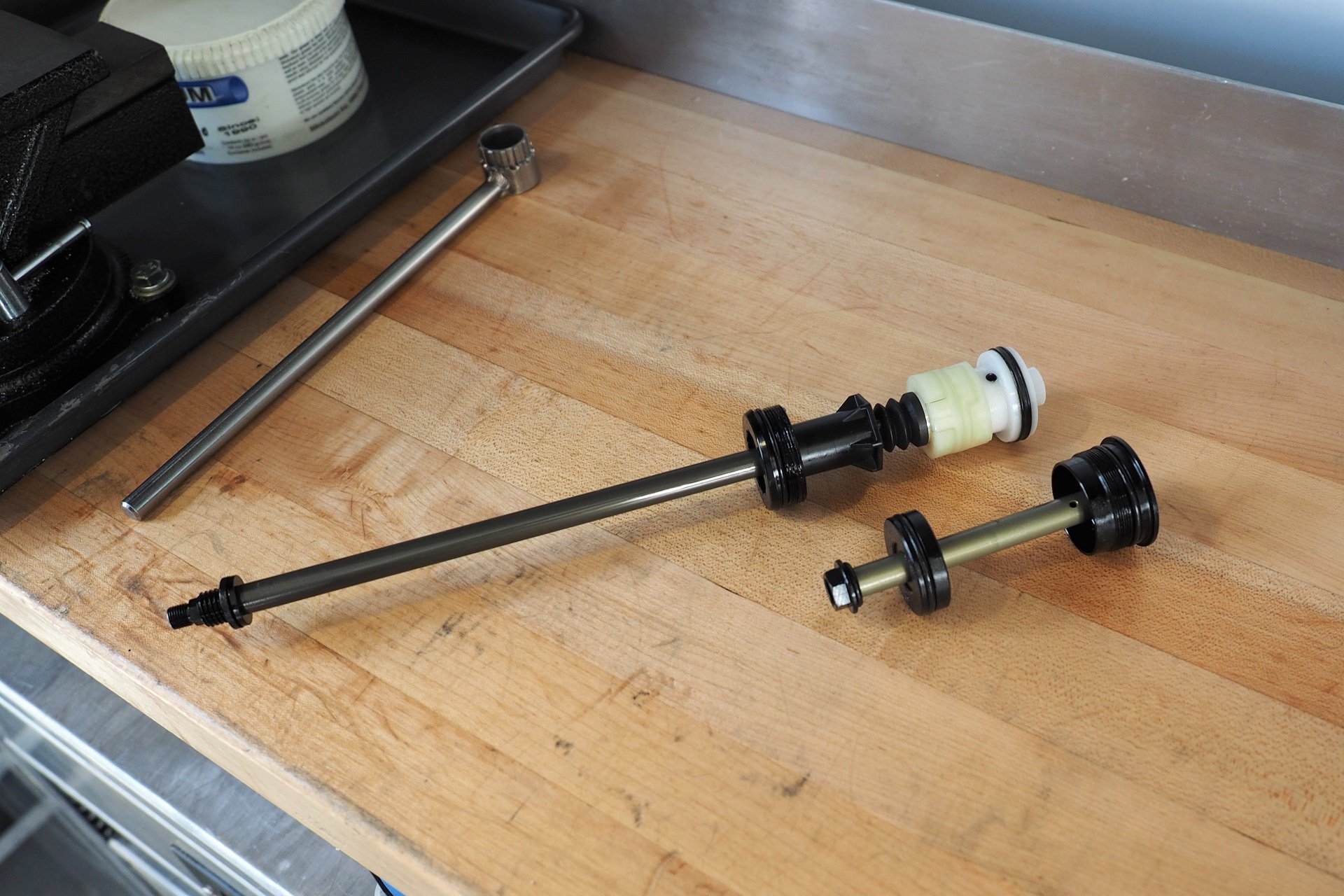
The Infinite Rate Tune air chamber, and valve, is at the top of the fork. The positive and negative chambers are inflated from the bottom with a special valve that opens both at the same time.
The rabid return to coil shocks and the increasingly coil-like capabilities of air shocks, has riders running firmer setups out back and the less-sag-but-all-the-traction support needs to be matched by the latest breed of suspension forks.

IRT allows the rider to tune the feel, and engagement, of their mid-stroke, independent of bottom-out, so the Mezzer can be initially plush but also ride high in corners and steeps.
My Manitou Mattoc ( née Magnum) review, and my extensive experience with that fork, undoubtedly helped me with my initial setup of the Mezzer. The 37mm Mezzer chassis is as stiff as any single crown fork I've ridden, and frankly as stiff as any fork needs to be. The Reverse-Arch chassis, and patented hollow-crown allow it to achieve that stiffness at 2070 grams (my scale; uncut steerer) in a 160mm configuration including the Hexlock SL axle.
As mentioned in my Mezzer first look, the new chassis from Manitou realigns the Reverse Arch so the fork can match the axle-to-crown heights of its competitors without sacrificing tire clearance, or stanchion or steerer pressfit overlap - both of which are very generous compared to many forks on the market. The axle-to-crown for this 29'er fork, with 44mm offset, is about 575mm at 160mm travel and about 585mm at 180mm travel.
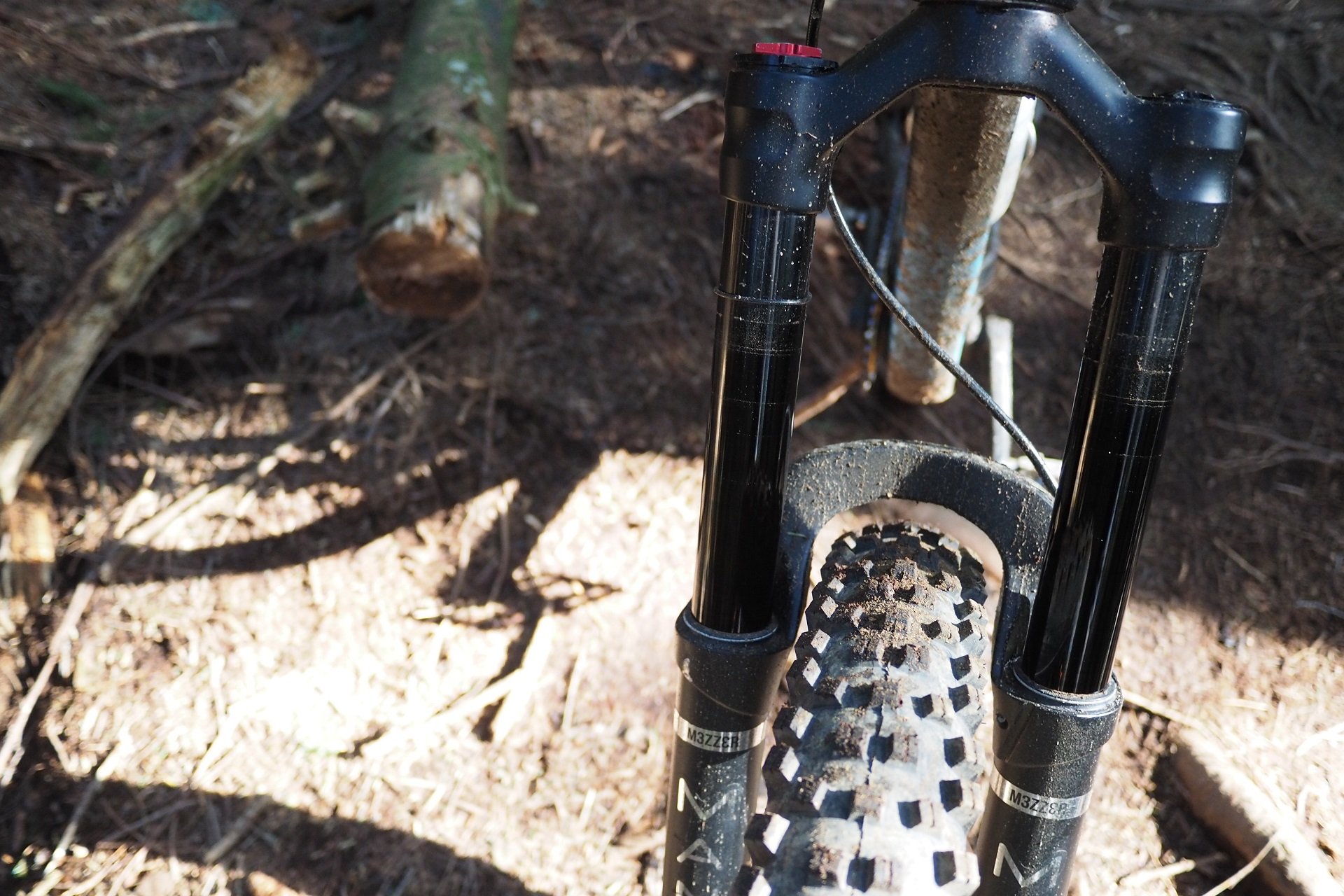
Massive tire clearance with plenty of room for a 2.8" WTB Vigilante on an i40 rim, although I need to drop to a 2.6" to clear Manitou's, included, fender.
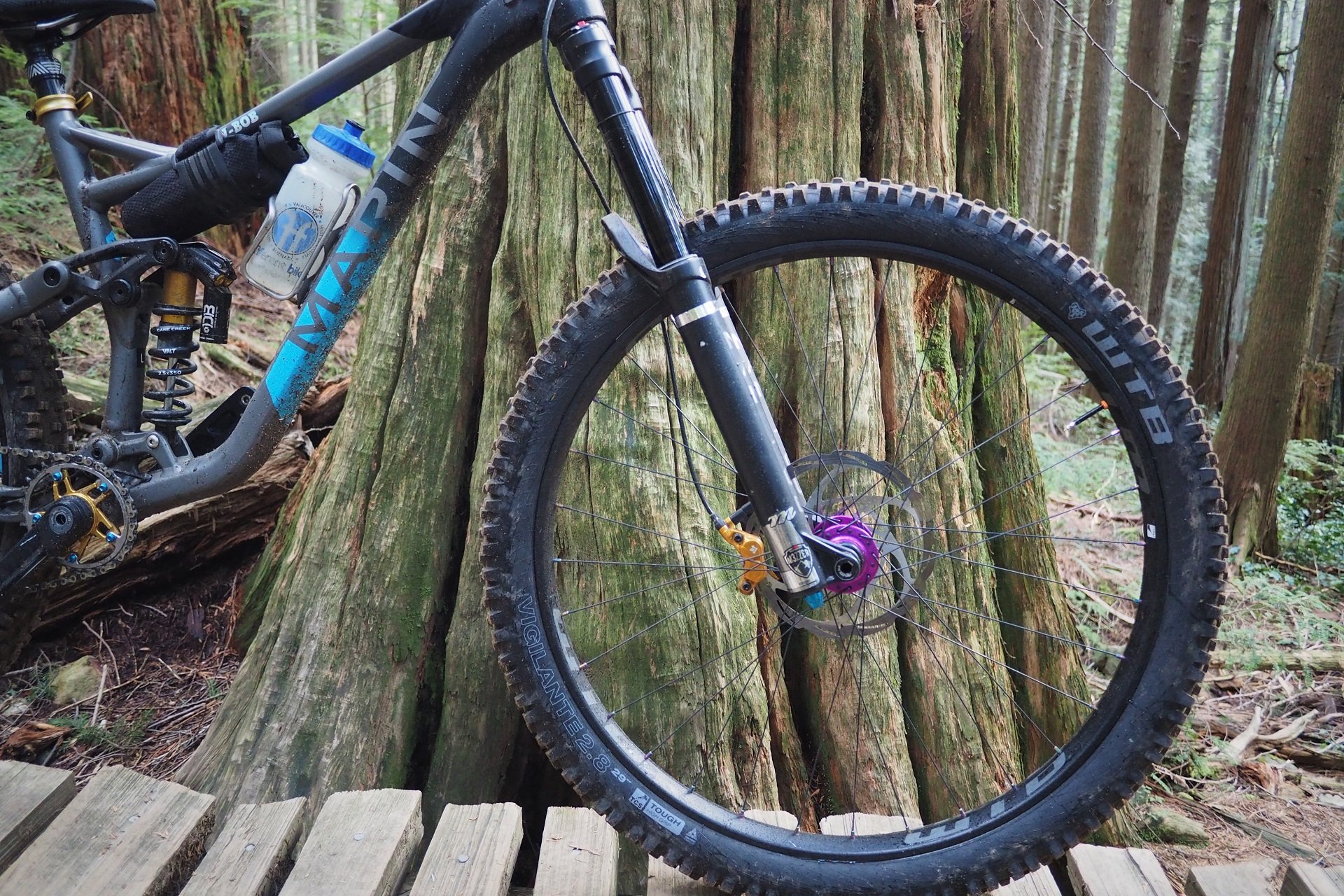
The latest Manitou chassis allows very healthy stanchion and steerer pressfit overlaps, and competitive axle-to-crown height.
Doing A 180
After over-forking my bike for the North Shore, from 160 to 180mm, I've found I prefer how my Marin Alpine Trail handles the local terrain. I'd also hazard to say this is the natural position for the Mezzer as I found it easier to balance with the main air springs (positive/negative) with the IRT system in this configuration. More on that later.
I started out with the Mezzer at the 160mm travel specification of both bikes I tested it on. All that separates a 160mm Mezzer from the 180mm are a couple of 1cm travel chips and the corresponding 20mm of axle-to-crown height. Initially, my desire to run the Mezzer at 180mm came from reports of early review forks developing bushing tolerance issues, which are most likely to occur with the fork extended to the maximum length, and minimum insertion. With the fork running tall, thanks to IRT, it's a lot of leverage on any bushing, or pressfit crown-steerer-unit (CSU), system.
I plan to continue riding the Mezzer into the future, once the world returns to normal and I can go back to pushing it as hard as I can in the wild, but to date, I've experienced no issues with the chassis whether it be creaking or bushing slop. The tight tolerances and fork stiffness are on par with day one.
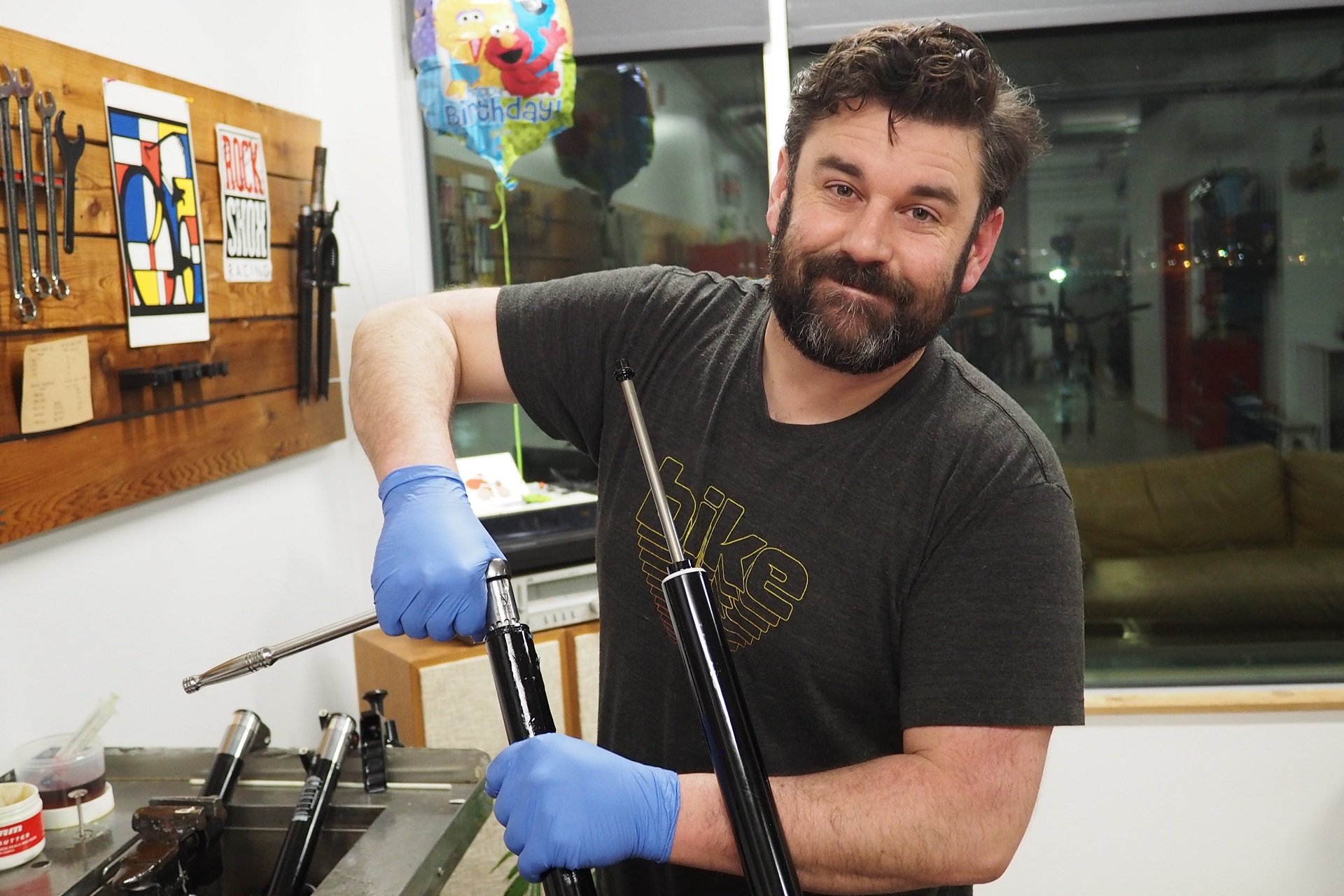
Hi Jeff! This photo is from the way-back-times, February to be exact. One of the things I miss the most is hanging out with my bike nerd friends taking things apart.
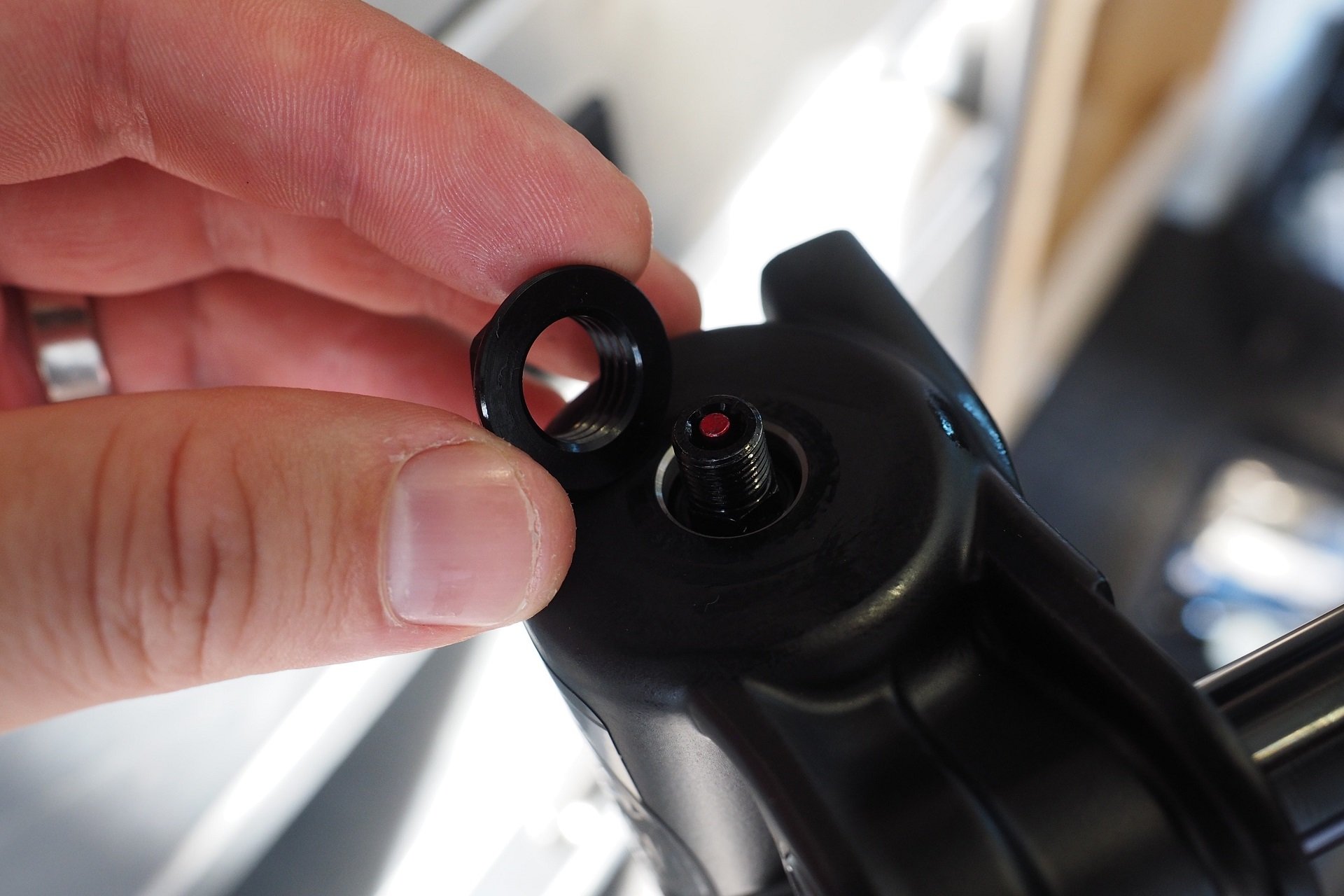
Travel adjust – remove the foot nuts and slide off the lowers as per the initial teardown photos.
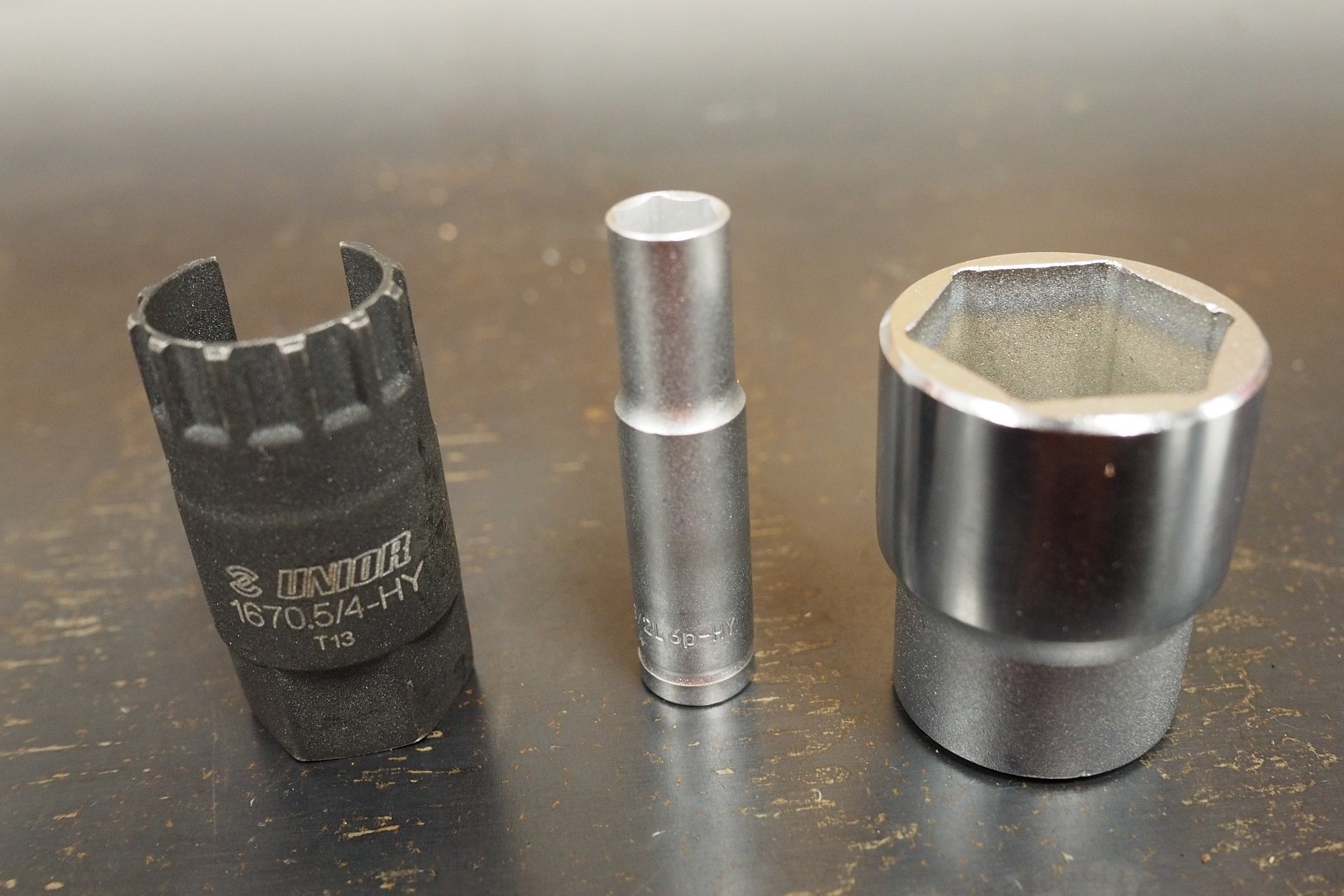
Manitou sells a fork service kit including the cut-down cassette tool needed to remove the air system. Just be gentle as the tools can fold on themselves.
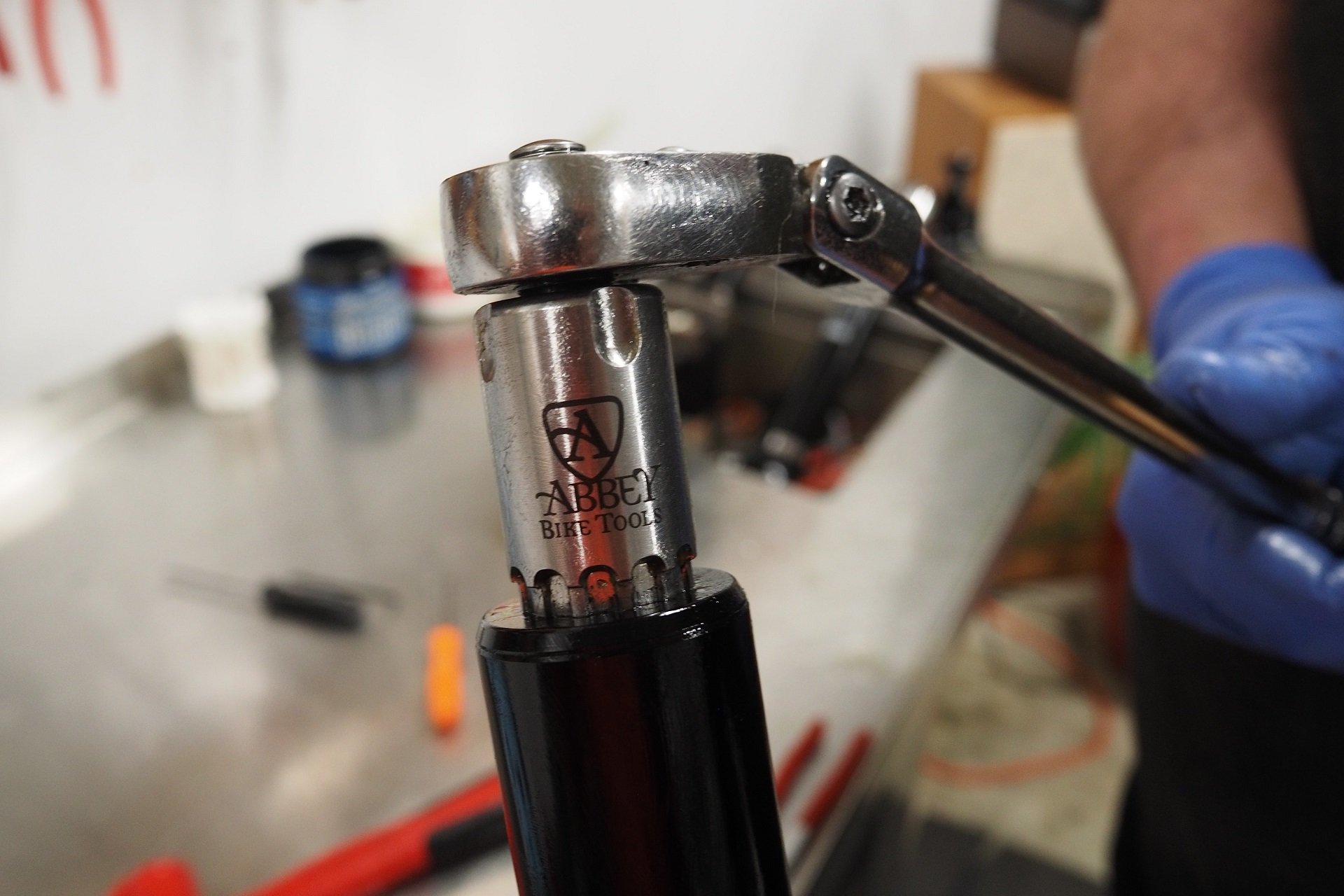
Jeff has this beautiful Abbey Tools Socket Crombie that does the trick for RockShox and Manitou. So jealous.
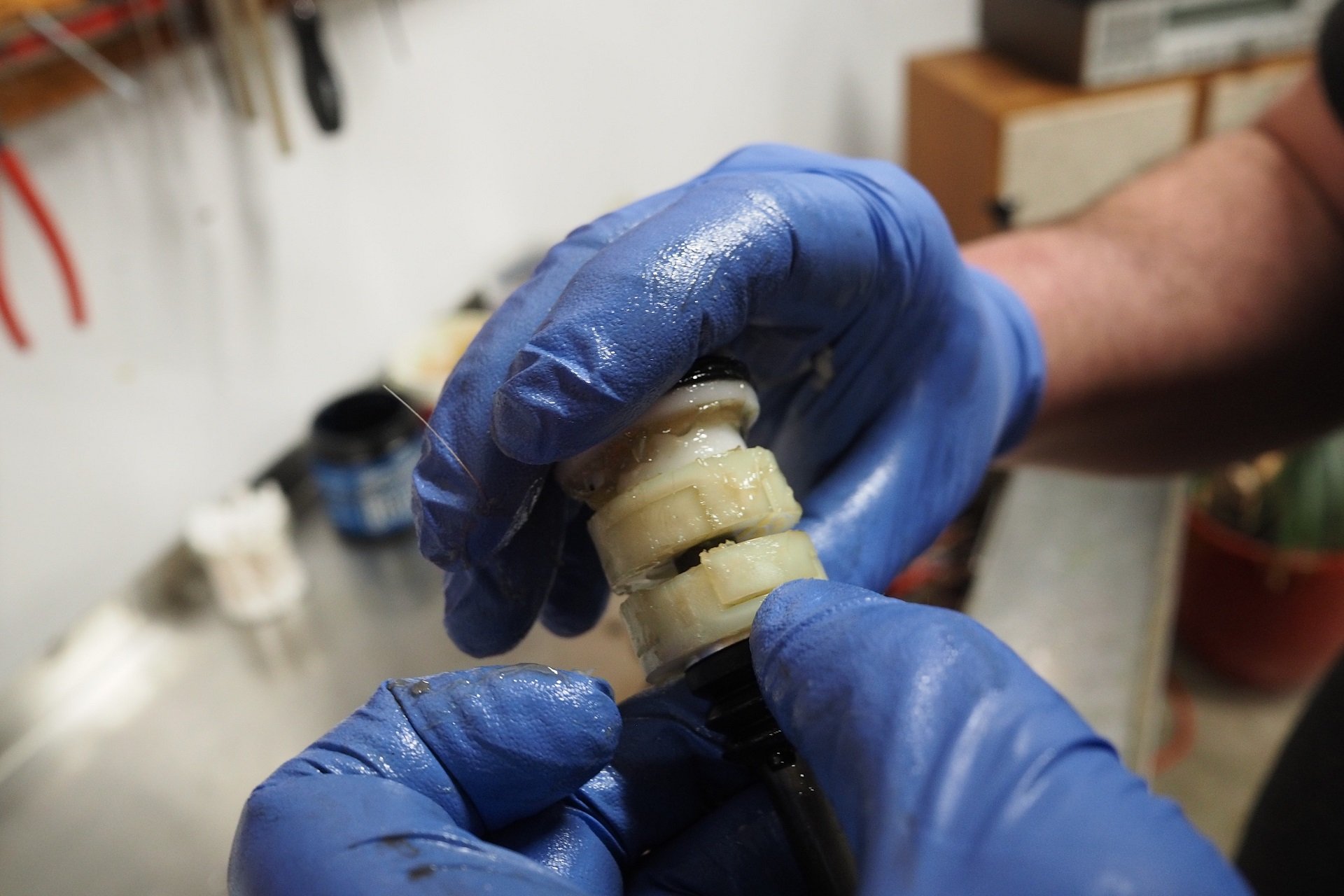
The travel spacers installed. I had initially planned to ride the fork at 180mm for a while and then add one back in to try a 170mm setup.
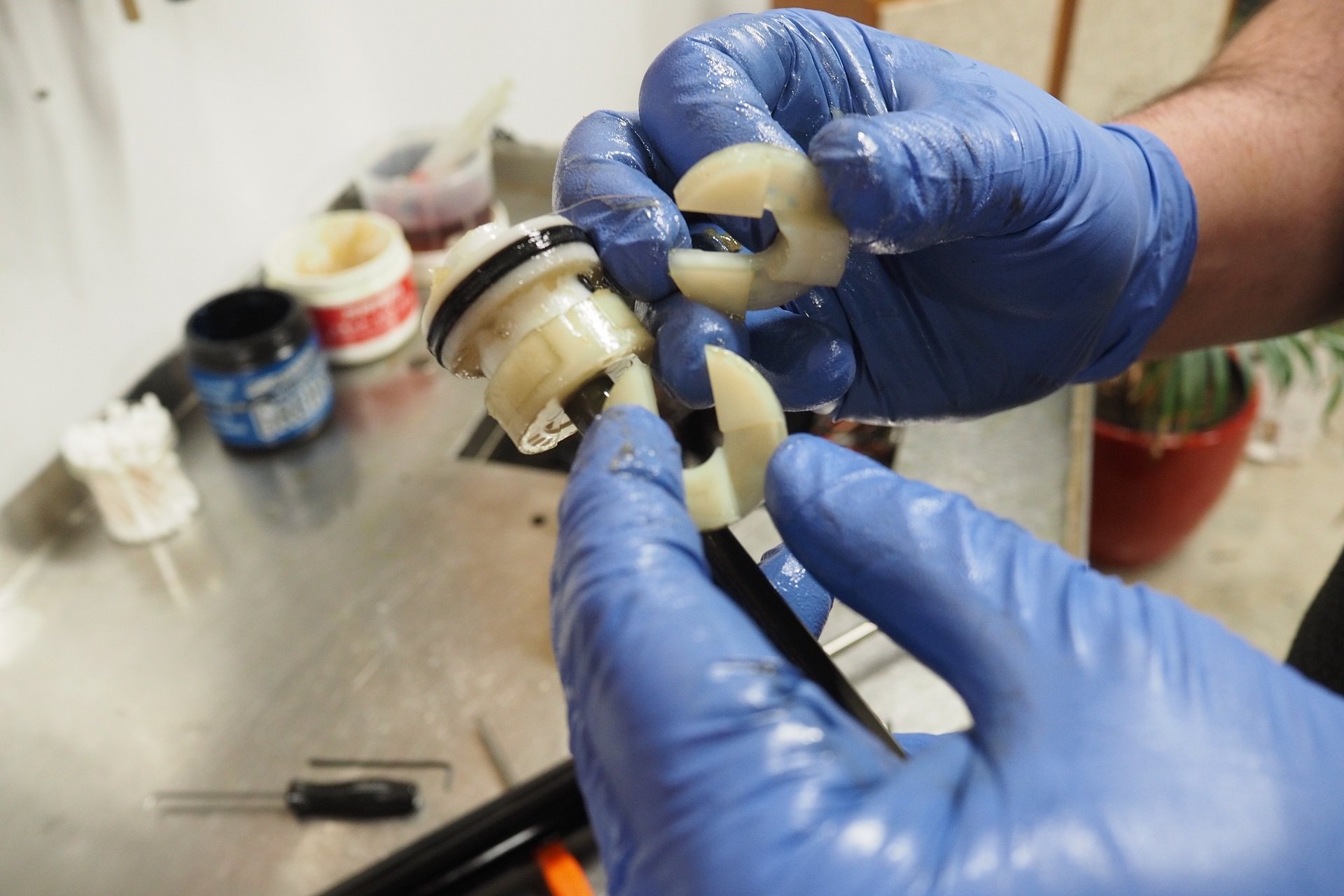
The spacers come apart in halves so that no further disassembly of the air system is required. It's nice that there's no additional expense required in the form of air shafts.
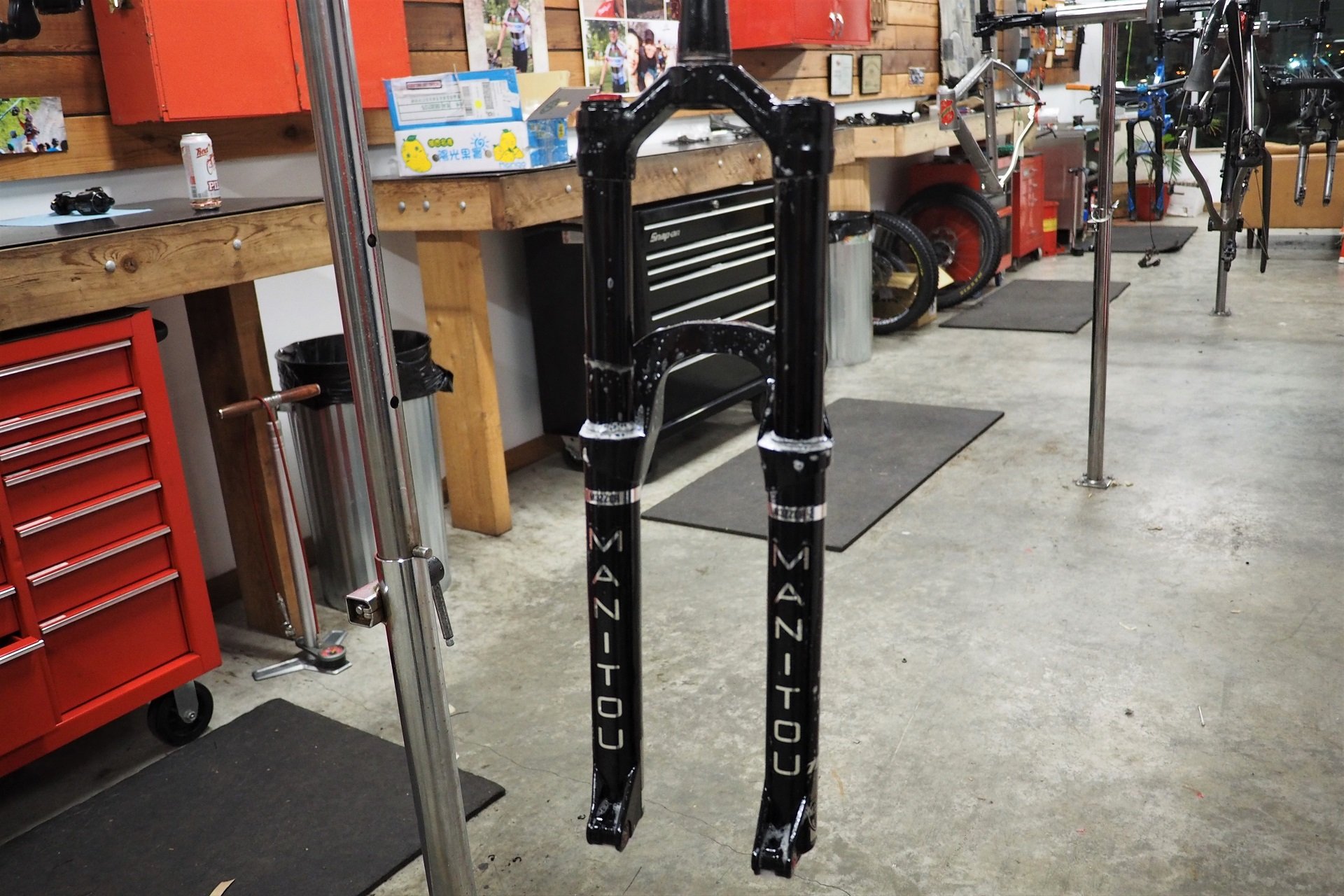
Washed thoroughly with soap & water. Yeah, I know, you've been reading that a lot lately. Jeff and I hopefully have some more projects coming up when life finds a new normal.
If you own a Mezzer fork and a bike that can handle 180mm up front, drop the lowers and give it a go. It's easy enough to replace the travel spacers you don't like it. More than other forks I've ridden, the Mezzer air spring feels best at full travel. I also found it easiest to find a balance with IRT in this setup. I'm around a buck ninety though I'm not certain it's relevant in this case.
The Mezzer has me wishing I still had a long travel hardtail setup. Coming off of my rigid or my Helm at 17% sag, I think this fork, run full bore on the front of something steel with a 450mm rear center and a 62° head tube angle, would be amazing with IRT set up to ride high.
Hayes-Manitou has put together a solid service manual, along with contacts if you need a hand, for the home mechanic looking to perform a full service on their Mezzer.
Settings
I thought I'd miss the adjustable hydraulic bottom out of past Manitou forks but whatever setting they chose to go with obviously works perfectly for me. I haven't bottomed the Mezzer's air spring often, but when I have the hydraulic bottom out system works excellently. It adds to my previous wonderment that all top-end forks aren't using something similar.
Staying with the damper, I anticipate that future Mezzer forks will come stock with a less aggressive setup. This first-gen platform reminds me of the first run of 2015 Fox 36 RC2 forks which came set up with the kind of tune that Team Yeti's Jared Graves and Richie Rude were running rather than something usable by mere mortals. I'm running the High-Speed-Compression (HSC) in the open position which interestingly, to me, is the same as my setup with the Durolux RC2 PSC but not my experience with the Helm or with the X-Fusion Trace 36 or Ohlins RXF where I add HSC. I'm not a suspension engineer but I think that, as a mid-level rider at 190lbs, if I'm running the HSC wide open the stock valving is probably too aggressive for their average customer.
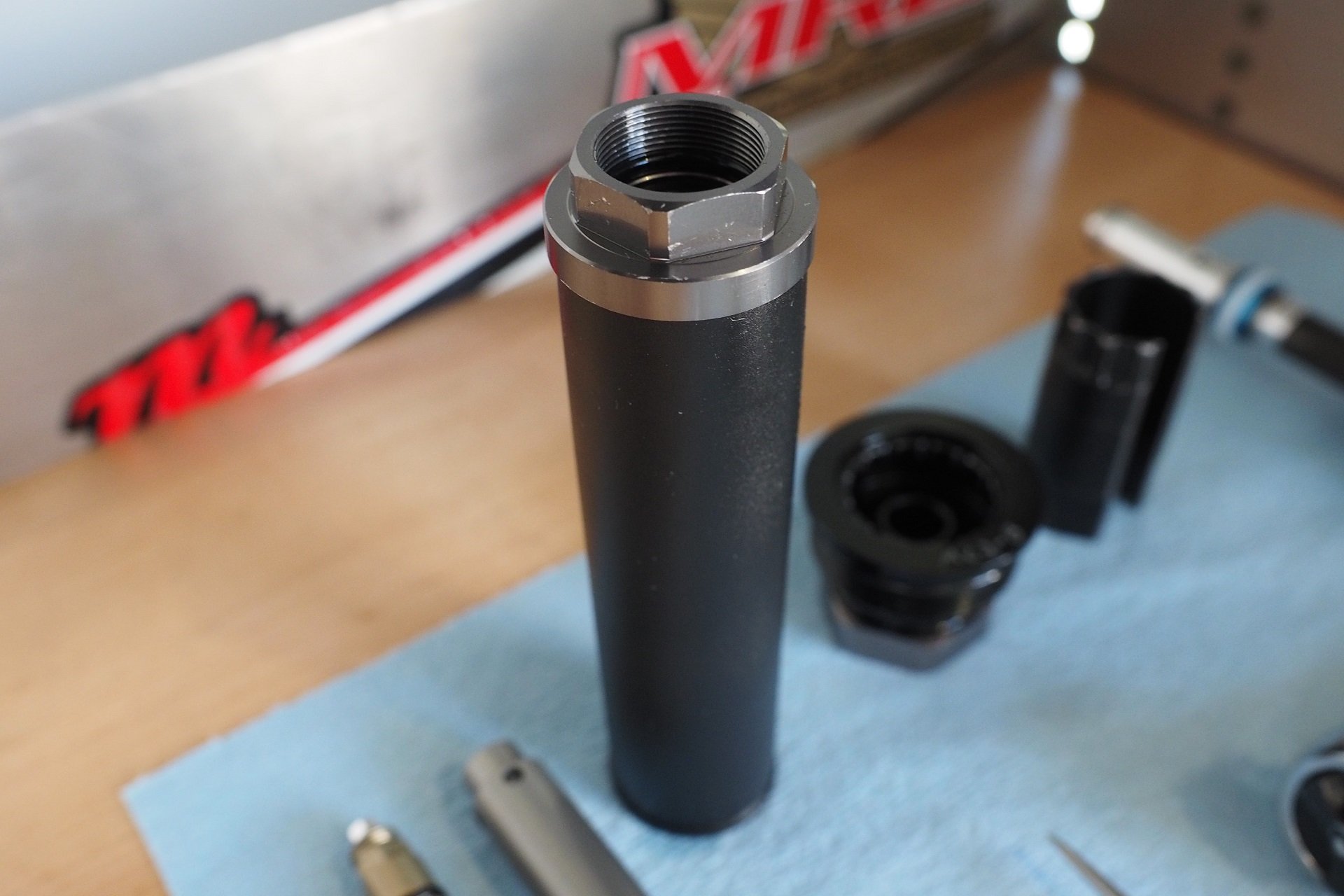
I'm an absolute fan of expanding bladder dampers going back to the first Fox FIT forks. Give me clean & easy lower services every day of the week.
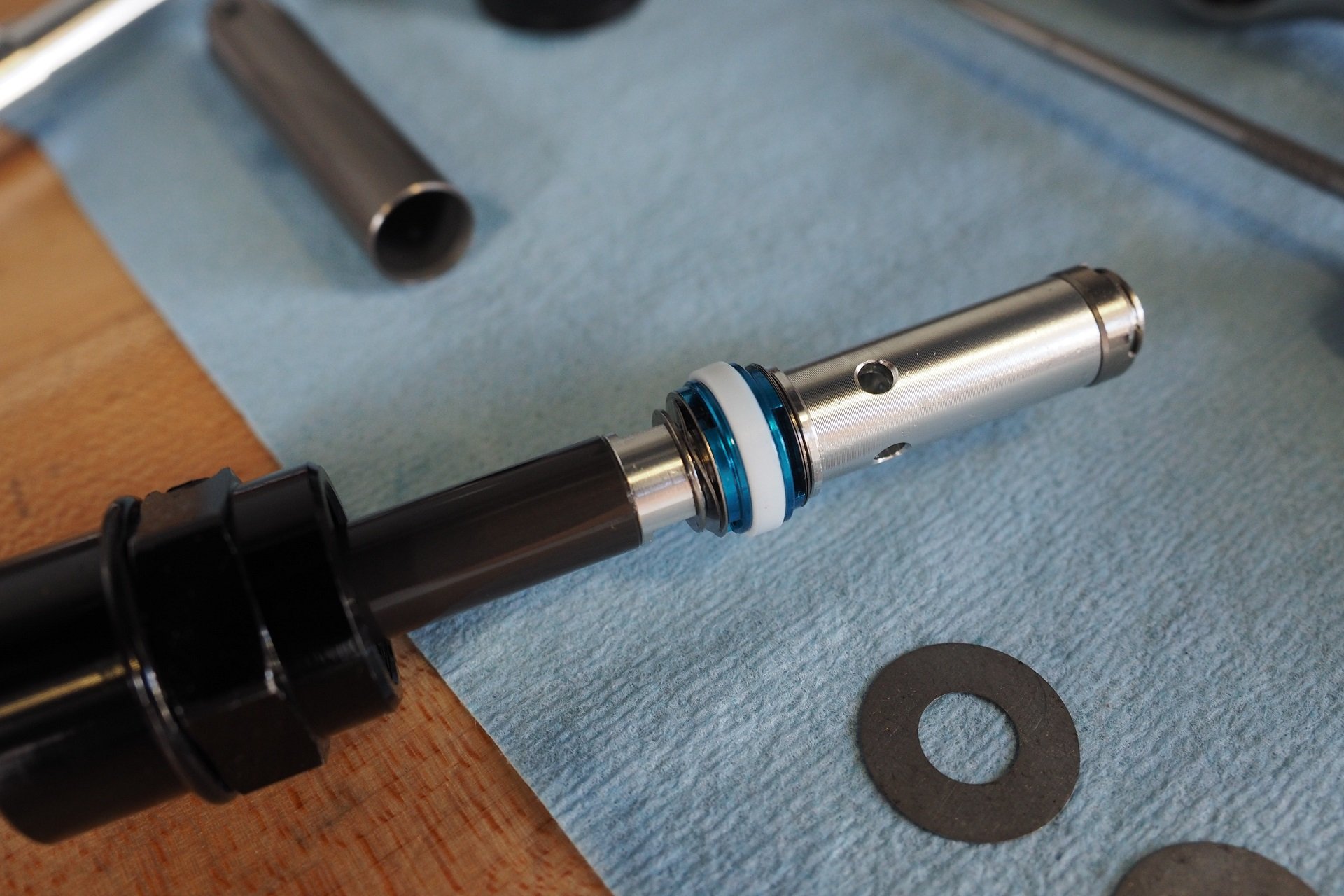
I applaud Manitou for going the route of their sealed MC² damper and for continuing to use a, now non-adjustable, hydraulic bottom out system. I wish the HSC adjustment had a usable range however.
I'm running the low-speed compression (LSC) at 5 clicks out from closed (-5) out of a possible 11 clicks, so again fairly open for my weight and I ran identical compression in both the 160mm and 180mm travel settings. On this note, I would love to see more companies go the way of Formula's CTS and offer drop-in valve sets. They could offer a generic wide-range setup for OE applications and then custom tuning setups that would give a rider a usable range within a weight class the way Avalanche does.
This isn't a Manitou-specific complaint, but I'd love to have more than 1-3 usable clicks of rebound an LSC adjustment and more than 1 usable click of HSC adjustment on a high-end suspension fork. It's not that I'm unhappy with the performance of the MC² damper, quite the opposite, but who's to say that with a more micro-tunable range it couldn't have been that much better?
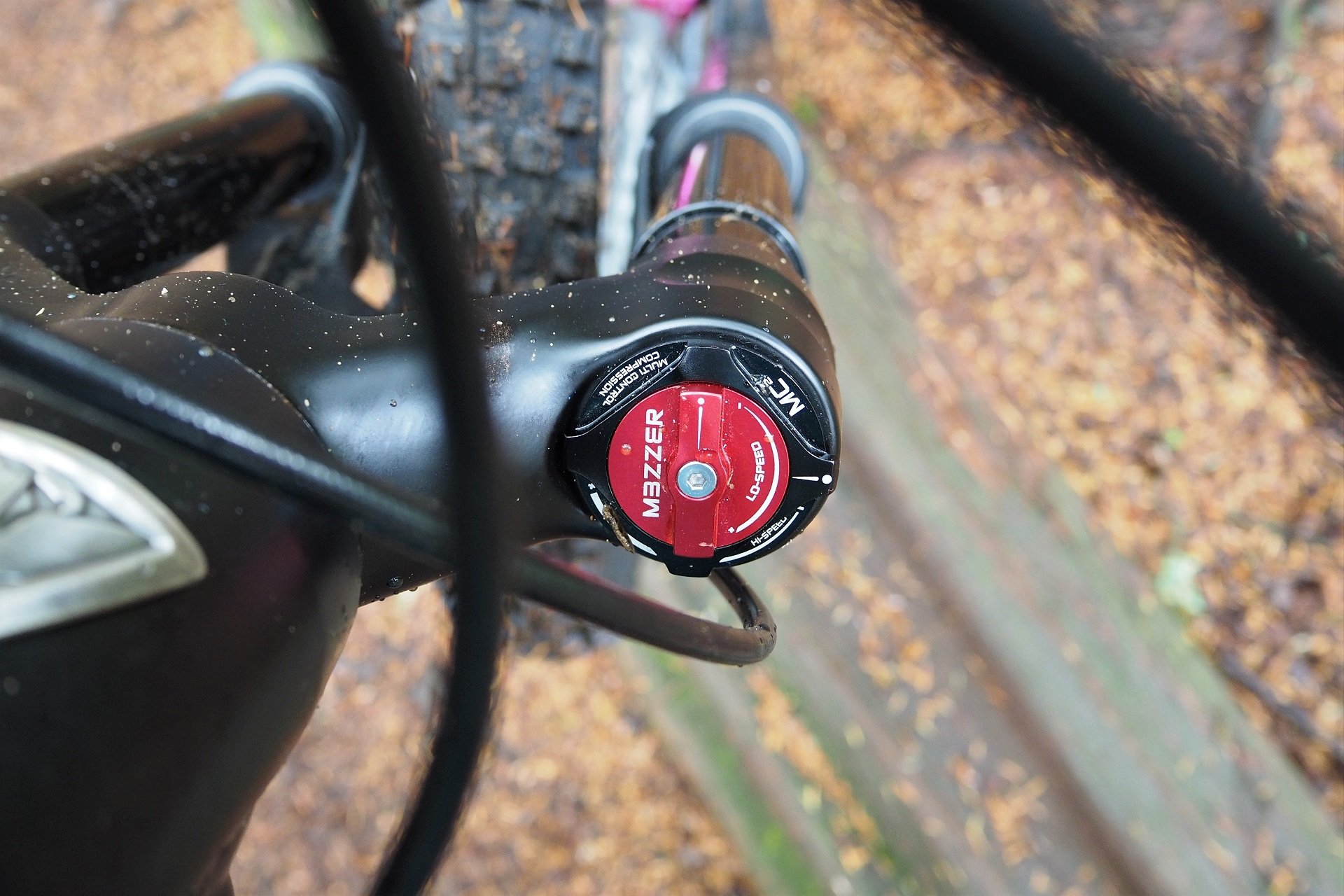
I ran the HSC adjustment wide open and the LSC at -5 clicks from closed (out of 11). As a mid-level rider of 190lbs I'd hazard to say that points to the MC² damper being valved a bit aggressively for the average rider.
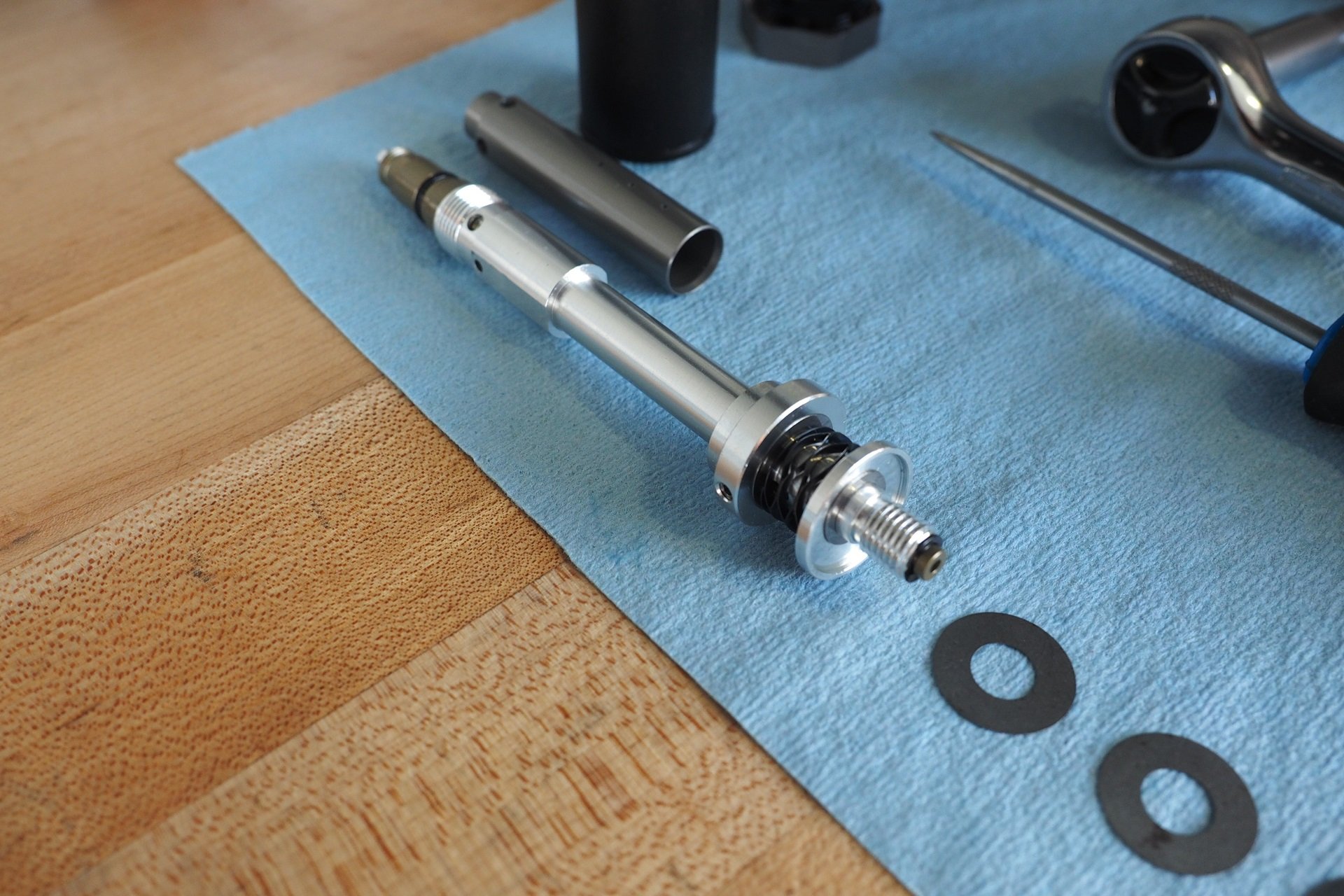
In Canada either Smithtech or S4 Suspension can re-valve the dampers. In the USA and Europe you can contact Hayes-Manitou directly.
On the air spring side, IRT is not all chocolate-covered unicorn turds. There is no chance that five minutes with a shock pump at the trailhead is going to yield your best suspension setup. If you are not willing to expend a bit of thought and effort bracketing your best setup, then Manitou's IVA air system or any number of other forks would be a better option. There's nothing particularly challenging about putting air into the fork or dialing in some base damper settings. But, the nature of having three air chambers inside the Mezzer and all those chambers being relatively low volume, is that a few psi will make a difference in performance. 'That guy' who isn't particular about the pressure in his fork is going to end up with a suspension experience that's all over the map.
My suggestion is to first air up the IRT chamber to 1/2 naked body-weight and then air up the positive/negative chamber to 1/3 naked body-weight and then bracket both the total positive/negative pressure and the gap between main pressure and IRT pressure to find your best personal settings. If it helps I'm running 20% sag.
One last piece of setup advice that's true for all Manitous forks using the Dorado Air Spring, is to make sure there is no weight, not even the weight of your bicycle, on the front wheel when airing up the main air chambers. Because the valve is opening both the positive and negative chambers* at the same time, weight on the front end will cause the fork to suck down.
*instead of a self-balancing negative spring, coil negative spring, or manually set negative air spring
I would love to see Manitou find a way to combine their IRT air system with the manual air-negative adjustment that Cane Creek uses in the Helm as I think that would be the best of both worlds in terms of a super-adjustable but somewhat idiot-proof setup.
Composed
With my settings dialed, in 160mm or 180mm configurations, the Mezzer is as good as any fork I've ridden. Maybe I'm a bit persnickety but it took me longer to get the fork to maximum performance. Once I had bracketed my settings, it delivers best in class traction bump absorption while standing high in its travel.
Hard on the brakes rolling through janky roots setting up for a steep rock section, I know the fork will push through and ride high, ready to absorb my poor line choices when I drop-in. It's not confidence inspiring to the point that I'm hitting additional features or noticing a jump in the speed I travel compared to other top-end forks. Instead I find myself more relaxed and flowing the unflowable more often than on other high-performance setups.
Thanks to IRT, the Mezzer is one of the few forks where I never play with my settings between slow janky Shore trails and some of the higher speed lines. On many other forks, I run a lot of LSC to resist panic-braking-induced fork dive on steep roll-ins but those settings will then feel harsh on faster lines. Once my settings were dialed I didn't touch the Mezzer between rides except to check my pressures.
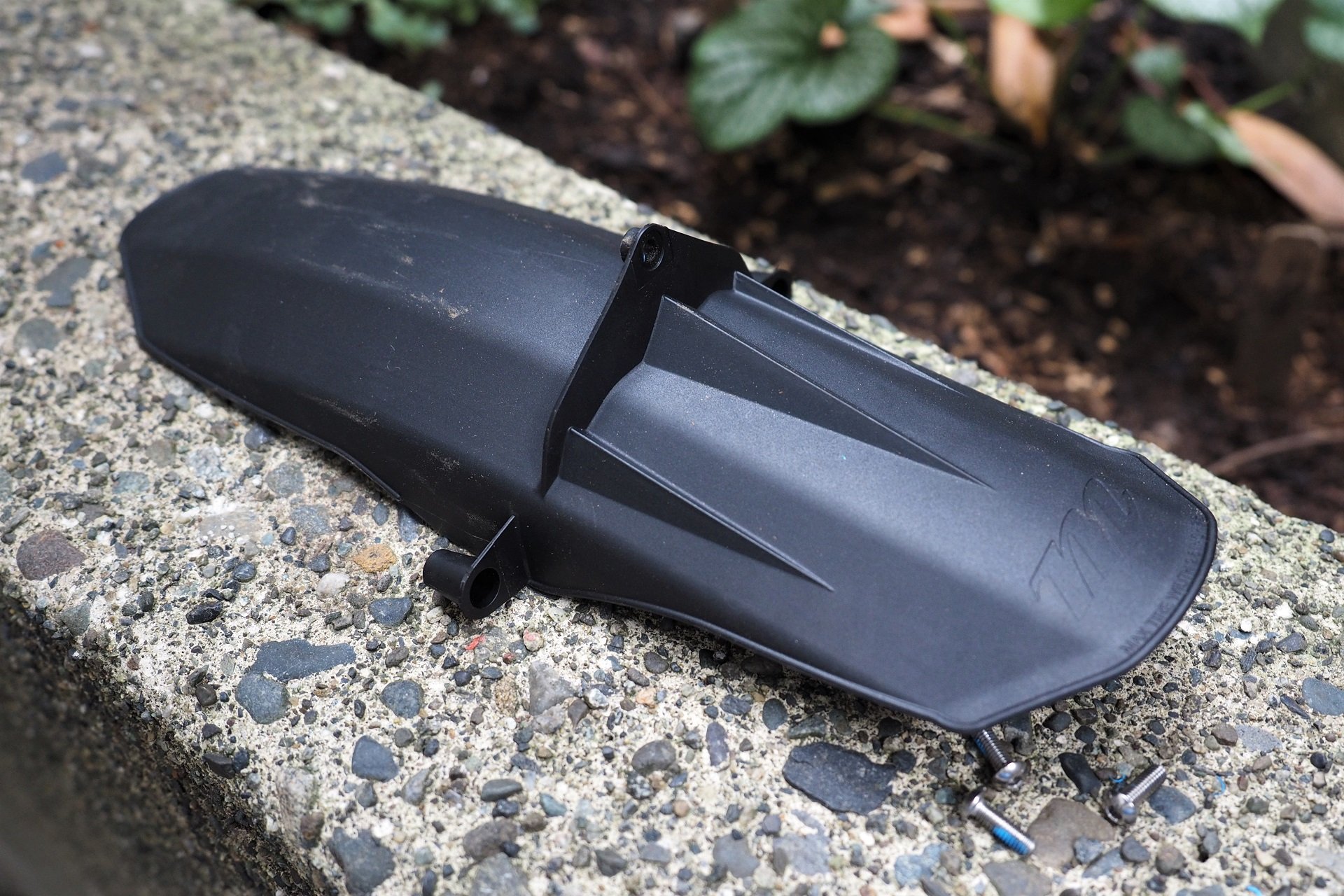
I have no love for the stock fender except to say it's quiet in use. I'd love to see the Mezzer come without and for Manitou to engage Muddhugger to make a nice Reverse Arch compatible fender for the aftermarket.
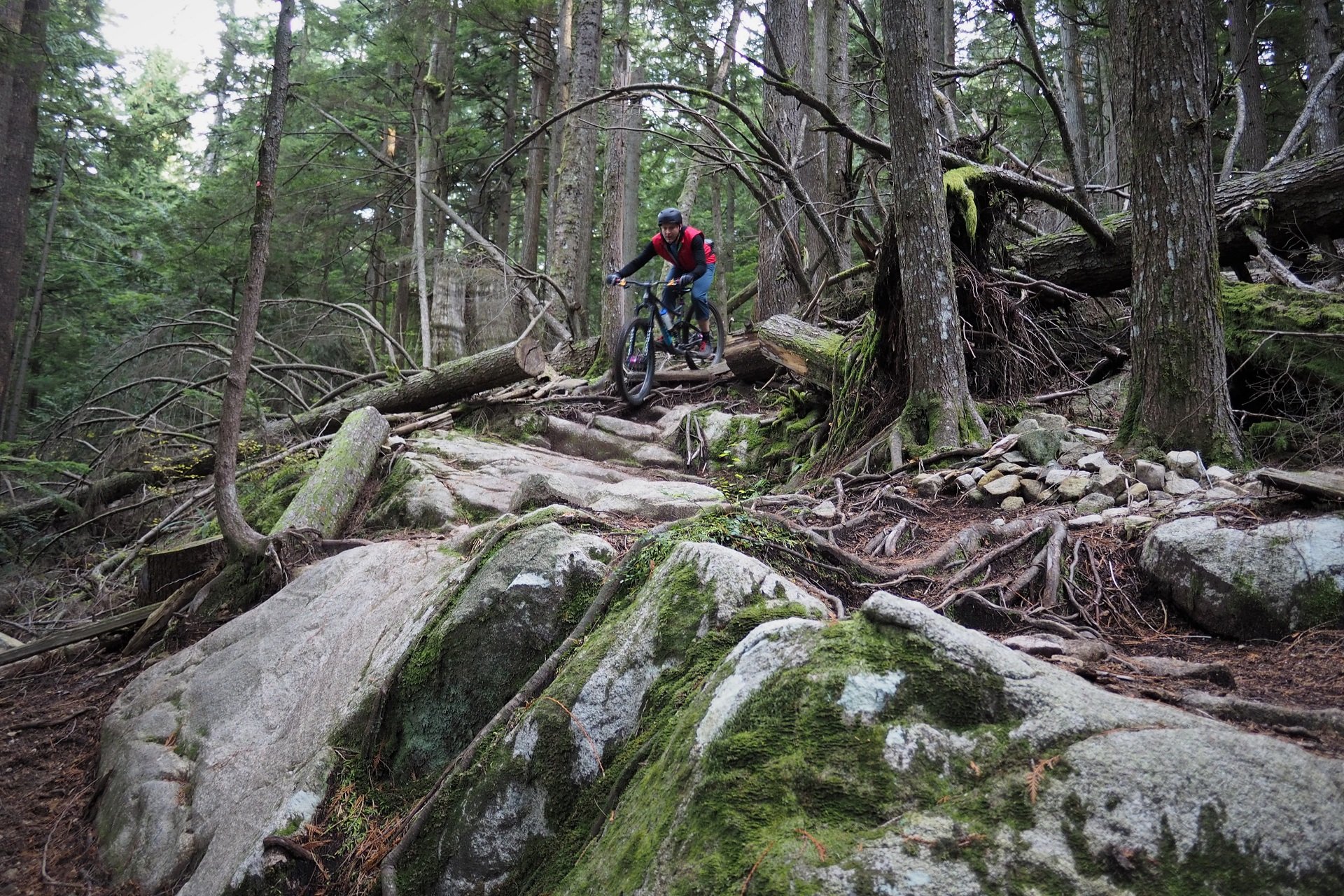
Other than the damper tuning options I mentioned above, there's nothing I'd change about the Mezzer.
The Mezzer also excels in an area where no Manitou single crown fork since the 90s has; aesthetics. I think the fork looks amazing. It looks mean from the front, it's got a moto vibe looking down from above, and even the side profile works it.
The retro-inspired decals draw more positive comments from strangers than any fork I've ridden besides my old 2014 Fox 34 Float Factory with nos 2003 metallic-foil Fox decals on it and while every other company is scrambling to win sales by offering a pallet of colour options for their lowers, I think Manitou would be best to just keeping hitting on black.
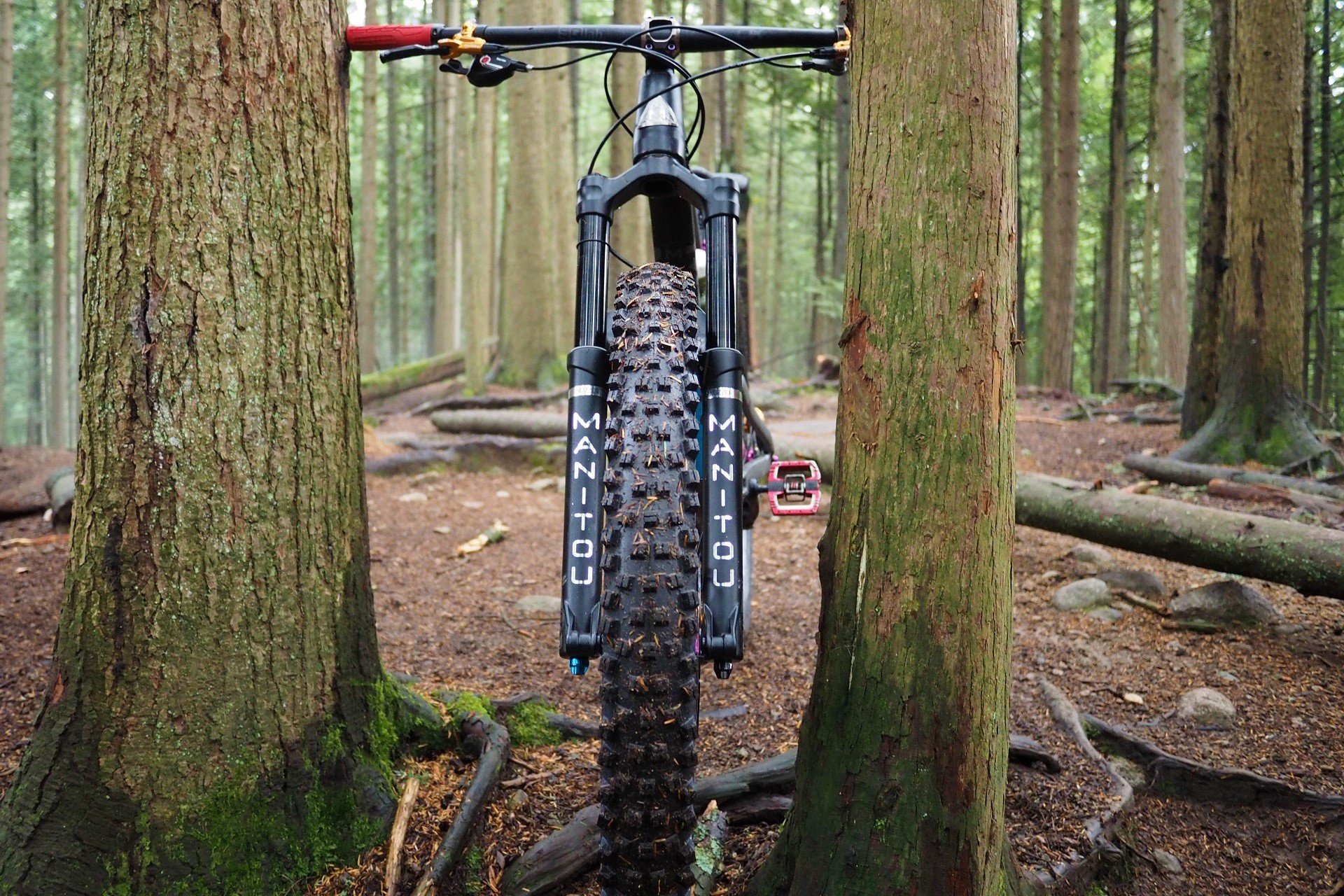
I think the Mezzer is the best looking single crown fork, arguably the best looking fork period, that Manitou has ever made and the baddest looking option on the market today.
Any way I ride it, the Mezzer Pro IRT delivers the ride quality, features, stiffness, weight, and manufacturing quality to justify it's 1000 USD price tag compared to what the competition is bringing to the trail. Where comparables are bringing different takes on the same basic package, the IRT air system offers something unique. It's not about being something for everyone in a sea of options, but rather offering a level of tuning and performance that will appeal to many riders over the other options on the market.
I think the Mezzer easily falls into my top-three, or four, for a fork I would purchase. Please hit the comments if you'd like to have a more nuanced discussion of the Mezzer v. the market or for more information check out Manitou.
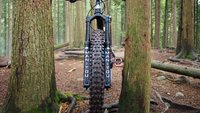
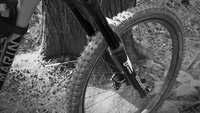
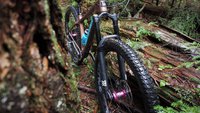
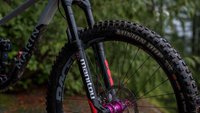







Comments
Bushpilot
4 years ago
What are the other forks on your top three or four list?
Reply
Andrew Major
4 years ago
Apologies in advance for the long response. It's a hard subject to cover without a high degree of context and I didn't feel it was adequate to just provide a list.
((Insert comment here about how there are lots of awesome fork options on the market, no bad bikes, user preferences, tester preferences, I'm a so-so rider and really slow, YMMV, and all that))
If I had to open my wallet for a fork tomorrow here's what I'd be buying:
1) My baseline forks are the Suntour Durolux/Auron PCS RC2. But specifically, my version which uses a coil negative spring. I haven't ridden the new forks with the self-balancing negative air chamber so I'll reserve judgment for the time being but I think they're the one company that really did coil negative springs right by offering multiple (4x total) rates which let riders easily tune for weight and preference without making the forks any more complicated.
The Dur'on lineup is easy to work on and adding 7-10ml of oil to the lowers (grease-lubed fork) makes them buttery smooth. The damping is not as sophisticated as other forks on the market but will suit most riders just fine and a competent tuner can custom valve the forks.
The chassis' are stiff and while everything pressfit will probably creak eventually, I haven't managed to creak one yet and I've seen used forks bought from Tippie, Buehler, and Doerfling that look punched and are still silent.
The forks are cheap and easy to travel adjust; however, depending on rider weight and how far you're lowering them they made need a bigger negative spring. I run the heavy negative on my Durolux and I find that works best in the 160-170mm travel range.
For something to warrant me paying more money it has to offer an obvious additional value (performance, ease of service, intrinsic) over the Suntour which isn't easy to do.
...
Reply
Andrew Major
4 years ago
(who knew there was character limit?!)
...
2) I own a Cane Creek Helm that I'm running on my V2 Walt hardtail. The air system works beautifully in terms of riding high in its travel and I love the manual balancing of the negative air spring. It's a really stiff chassis (even if the 35mm stanchions look small now). The fork is really easy to work on in terms of changing air volume and travel and travel adjust just uses clip-on spacers since there is no transfer port.
I'm running about 17% sag and quite a bit of damper support since it's on the front of a hardtail and it still does an admirable job of providing initial traction and absorbing small bumps on rough tracks.
So the Helm is a fantastic performing fork but I'm perfectly happy with the Dur'on and on the front of a hardtail where you aren't trying to balance a bike's suspension front/rear the sophistication of the damper etc isn't necessarily as important so where it wins my investment is the intrinsic value of being - arguably - the last true factory fork. Cane Creek is doing QC/QA on crowns, stanchions and steerer tubes in their North Carolina facility before pressing them together, building and dyno testing dampers in house, and then assembling complete forks on-site.
Because of how the negative spring works the Helm is both really easy to travel adjust and works great at a huge range of travel settings. I'm currently running mine at 120mm and thinking about trying 130mm and I've also ridden the fork at 160mm. It's just (really nice) clip-on aluminum spacers.
I'm early days on my Helm so I can't comment on the CSU yet personally, but I know of enough folks happily riding them now that I'm way more confident in it than other options on the market.
...
Reply
Andrew Major
4 years ago
(and finally)
...
3) Manitou Mezzer: Performance is excellent and I'm not afraid to take the time to bracket my settings. The bled damper means I can do multiple lower services before I send the fork in for service and a competent shop that handles suspension should have no trouble doing the damper. I think it's the best-looking fork on the market (not that that matters to mountain bikers, we only care about performance) and the chassis stiffness v. weight is excellent. I like being able to tune how high the fork rides in its travel v. total support from the air spring.
I love the hydraulic bottom-out system - on Manitou forks and also on the Avalanche cartridge I owned previously - and that's a big (small) selling feature as well in terms of differentiating from my Du'ron baseline (where I run enough volume tokens that the fork never really bottoms).
We're spoiled in the Shore-To-Sky with a few excellent suspension tuning businesses and unfortunately, none of them service Manitou (with Smithtech being based out of Calgary currently) so that's the one caveat in terms of making a local recommendation. It obviously doesn't apply to anyone living/riding where they'd be shipping their fork in for a high-end service anyways.
The Mezzer is easy enough to travel adjust; however, I felt that the air spring worked best (for me) in the longest travel setting (180mm) so I'd only be buying one for a bike that's compatible with that much travel.
...
4) Ohlins RXF M.2 Air. I know coil forks are all the rage (and I'm all over running coil shocks) but I prefer how air forks ramp up through their stroke, and how widely adjustable that ramp-up is with most forks. The Ohlins is sort of a stretch goal as it's an additional investment over my other picks. The forks are really nice quality throughout and it's another option where creaking CSUs don't seem to be a major issue.
QA/QC is a lot better than on middle generation forks - the RXF 34 I tested was amazing but there were some issues in between then and now for sure - because Ohlins has staff working out of the production facility in Taiwan. Damping is excellent (as you'd expect from Ohlins).
I wouldn't personally spend the extra money over the above forks because I'm min-maxing all my purchases but in the same way I wouldn't buy Cane Creek eeWings Ti cranks with my own money I can understand why those with the means would look at the M.2 as the most premium option on the market.
Hope that's useful!
Reply
Bushpilot
4 years ago
Very thorough and much appreciated. The Öhlins fork is on my shortlist to replace what I’ve currently got. I haven’t ridden one yet though so I’m glad to see it’s on the list!
Reply
Andrew Major
4 years ago
If you get the coil bug be aware that you'll probably want to go up one spring rate from what they recommend to get the support you need for aggressive riding. I think the air system is the better choice but coil is what most folks are talking about these days.
Beyond that, the newer models are brilliant forks. Super smooth (SKF seals throughout), great chassis, great damper. I don't think anyone who springs for one will be anything but stoked. If you go that route let me know how you like it!
Sandor Boros
3 years ago
Highly highly recommend it. Riding here in Victoria`s Hartland is everything but smooth. I have the M1 RXF 36 Air, on a steel hardtail and it is truly unbelievable. I can roll into the gnarliest rock roll transition and never feel that I bottom out, while the rock gardens feel like riding on some air mattress. Seriously great, especially because on the hardtail there is nothing else that would compensate for the terrain.
Lu Kz
4 years ago
I like how you managed to add an additional 2 paragraphs to a fork review by reviewing the same fork in the comment section of the very article where you reviewed the fork.
Reply
Andrew Major
4 years ago
Just trying to be helpful.
Douglas Ko
2 years, 6 months ago
What's you riding weight Andrew? Also why do you prefer to run it at 180mm? Does it ramp up too much at the shorter travel settings? I'm considering this for 160mm build and at a lower riding weight at 150lbs. So I have experience suspension that is overdamp and ramps-up too much.
Reply
blaklabl
4 years ago
I sent you an IG message regarding the Helm.
Reply
Andrew Major
4 years ago
Cheers!
Reply
Vincent66
4 years ago
+1 !
I'm riding a Durolux upgraded with an open bath cartridge and a coil spring, both suited to my weight, needs, ...
Chassis is very stiff for my 85kg and custom cartridge and spring correct everything I had to complain about with stock damping and spring.
I see me as spoiled kid with expensive toys and always asking for something more this or that ...
Reply
Andrew Major
4 years ago
Tease! TEASE!!! Who’s open bath cartridge are you using?! One of the Avy options?
Reply
Vincent66
4 years ago
It's CRConception. French company.
The guy started the company about 15 years ago.
He produces his own forks now.
I bought my first cartridge for my lyrik back in 2009 ; still working great !
In 2010, I moved to the US, and tried an Avy ; It was better than stock, of course, but I preferred the livelier feel of the CRConception.
Just when I moved to BC, I had problems with my BOS deville : as you all know, BOS customer service is just non existant. Same goes for customer respect ...
So I found a cheap durolux on sale (based on your review and teardown), contacted Richard (the "R" in CRConception) and few month after I decide to go for his option.
It has low speed rebound and compression external adjust and internal hi-speed compression and rebound, via shim stack or some other witchcraft.
Coil spring is "sur mesure".
It works fantastically ! I am not disappointed.
Reply
goose8
3 years, 11 months ago
Thanks for the thorough review, and for taking the time to compare the mezzer to other forks. Quick question about the durolux- did you ever feel like it raised the front end up extra high? Looking at the axle-measurement and it seems long...
Reply
Poz
4 years ago
Your opening paragraphs made me feel smug! I’ve always felt the typical softness and sag people run to be almost unnerving to me. Firmer is always better. That said I’m 230 geared up and happily ride a Mattoc Pro w/ IRT (very much based on your first reviews BTW).
That other site mentioned the Mezzer had some clunks and was a little unrefined. What did you find in regards to this, poor setup?
Is 160 the lowest it can go or can it do 150? I agree I love the, decidedly subjective, looks of this fork.
Reply
Jcmonty
4 years ago
The fork comes with spacers that let you go down to 140mm. So - you can buy a 180mm and get it down to 140mm or anything in between in 10mm increments..
In terms of the issues, I think Manitou has that under control either for QCing existing forks (mine is of that variety) or offering new lowers in the latest runs.
Reply
Andrew Major
4 years ago
Manitou states the travel is adjustable from 140mm to 180mm via their spacers. It may be possible to run it even shorter but I didn't try. I road the fork and 160mm and 180mm travel. I did find the air system on the Mattoc Pro easier (faster) to bracket in that's most likely due to the fact that shorter travel platforms are always easier to ballpark.
I was quite happy with the fork at 160mm and only bumped it up to 180mm after hearing about the Pinkbike review. That puts the most leverage on the bushings and I wanted to be damn sure that this Mezzer was as tight as I thought it was before submitting my review. This is a production fork and the chassis is definitely A'Ok.
The only thing that could use some refining in my mind is the damper tune. At two bucks thirty, you may feel quite different about the subject (i.e. support perfect) but it's one of the plagues on every company trying to do something for everyone. Manitou could offer shim kits and diagrams to make retuning easy for the mechanically interested end-user.
Reply
Jan Meyer
4 years ago
I'm using a Helm Air fork at 170mm on my Zerode Taniwha (160mm back), loving it, but always looking forward. The Mezzer and the Öhlins RXF 36 Coil (you don't have an air version review yet!!!) are my most likely next options.
For comparison I've already had the Pike (2016) and DVO (2018) on it.
I also have a Dorado DH fork (2016) with the IRT system (aftermarket) and that is just simply insanely good! So good I've contemplated putting it in 180mm mode and using it on my trail bike instead of the Helm. It adds a kilo of weight though so the Mezzer is looking mighty interesting at the moment...
For me the shootout it between those 3 forks, forget money or setup difficulty, I will spend the time to get it right, which is the way to go?
I'm roughly 190lbs and running the Helm at 80psi for a sag of 22%-ish.
Your answer will guide my life choices... no pressure.
Reply
Andrew Major
4 years ago
HAHAHAHAHAhahahahahaaaaa. Have you tried the Helm with a bit less sag? Where are you running the volume system at on the stack?
IRT is excellent and the Mezzer is an impressively stiff package that's also surprisingly lightweight. You may run into sub-optimum offset depending on what your Dorado is running but it's a great fork so if you already own it I would drop the travel and try it for sure.
Reply
Jan Meyer
4 years ago
I was running the Helm at around 90psi up until a week ago (not sure what the sag % was) but it really didn't track very well on the trails here. I got a lot of feedback on the arms and felt a bit deflected off obstacles. This was based on the manual setup guide which recommends 50% of body weight in psi. I saw one of their videos and the guy recommenced 40% of bodyweight so that is how I ended up at 80psi. It really tracks well now and is more in sync with my rear setup.
The volume is factory standard as I am not bottoming the fork. So 2 steps from highest volume I believe.
Reply
Andrew Major
4 years ago
Jan, a couple maybe helpful thoughts:
Mountain bike forks have a miserable life between the day they’re assembled and the first day you ride them - and some more than others. Stored in ways where lube isn’t sitting where it’s supposed to etc AND most brands are very over cautious with the seal lube because most riders will think their fork, shock, or dropper post seals leak if 2ml of assembly lube overage purges out.
If your Helm doesn’t feel awesome out of the box I’d drop the lowers, check the bath oil, and generously lube the seals with Slickoleum. Once you eliminate stichion it’s way easier to dial in air pressure.
Also, whether letting your bike sit for a week of recovery or a few months of offseason, most mountain bikers still store their bikes flat (on the wheels) which results in seals/bushings getting dry and really shortens the between-service performance curve. If you store your bike vertically (hanging from the front wheel) it makes a big difference over the course of that 100hr service interval.
Reply
blaklabl
4 years ago
I'll add my Helm Works 130 experience; I agree with Jan (above) that I needed the air pressure to be closer to 40% - 45% of my body weight to get to a more reasonable sag number as well as less stiff feel OTT. But, I will also say that Andrew has a point on the lube issue. I rode mine for about 700 miles, thinking it was super firm and thinking it would "break in" over time. I recently did the seal and lube service and it is like a different fork. Unfortunately that's when I also discovered about running less than suggested air pressure, so I don't know what had the bigger impact but they probably both helped. With lower pressure I also had to move the volume adjustment back closer to stock, as I had been decreasing it over time because it just felt like I wasn't using all the travel and it was just "too firm".
I've never been much of a tinkerer, but this episode has made me resolve to spend more time dialing in my ride quality and settings, instead of suffering through it.
Reply
Jan Meyer
4 years ago
"If your Helm doesn’t feel awesome out of the box I’d drop the lowers, check the bath oil, and generously lube the seals with Slickoleum. Once you eliminate stichion it’s way easier to dial in air pressure."
Going to do this today. Thanks for the tip.
I'm also going to be more vigilant in tipping the bike upside down for a few minutes prior to heading out for the ride. <- one of the reasons I love an USD fork like the Dorado.
Reply
Jan Meyer
4 years ago
Follow up: that did the trick!
Went for some test laps on the same short rocky DH so I can compare settings. Started at 85PSI and even then it felt way better on the fire road in. Did 2 laps on that setting and it felt really good. Better than at 80 from a few days before.
Went to 90 PSI again and that felt really good when things got rowdy but then I could feel the fire road chatter on the way back up. Did 2 laps on 90 to confirm.
BTW, the fire roads in Australia are brutal. Baby head loose rock everywhere. Beach like soft sand over it all. Compared to fire roads I’ve ridden in NZ and US the Aus fire roads are crazy hard on you. I’m making this point just in case people think fire road chatter is really small bumps. Not here.
In the end I think I’ll settle on around 87 PSI which is still nearly 10% more than before and it feels really nice and supple. Ran out of daylight to try that setting today.
Sorry for highjacking a review on the Mezzer for a discussion on the Helm. I’m still looking at the Mezzer with dreamy eyes...
Andrew Major
3 years, 11 months ago
Cheers Jan!
No worries on the hijacking, the comments section is always a great forum for free discussion and it's almost always fun to see where it goes.
Did you change the volume at all with the fork being smoother? Some folks find (all forks / in general) that they need less volume spacers/reduction when they're running their forks with a higher spring rate and more spacers/reduction when things are stiction city and a less air is being run to get things moving easier.
Jcmonty
4 years ago
Great timing! Just got my mezzer over the weekend and have been playing with settings in the yard. I have a lyrik with DSD Runt (same concept as IRT) and a Push HC97 damper that I will be comparing against ( though admittedly on different bikes).
I have read that some folks on certain forums are starting to retune the damper to be a bit softer. Curious to see how I find it.
Edit 1: I picked mine up on sale for $800. Not sure if the deal is still going but it was a bargain!
Edit 2: I am running 160mm. Wonder if going to 170mm and running higher sag (as I would want to keep the a2c at close to the 160mm equivalent) would be the best of both worlds? Softer off the top but with the irt , mid stroke still feeling great.. hmm
Reply
Andrew Major
4 years ago
May I ask how much you weigh? What bike is it on?
I don't know about more sag as I run my stuff fairly firm but keep in mind that going from 160mm to 180mm is under a degree of difference to HTA/STA and a much smaller overall change to the balance of your suspension compared to over-forking a shorter travel bike (120mm to 140mm is a ~16.5% change / 140mm to 160mm is a ~14% change / 160mm to 180mm is a 12.5% change) and that's before sag.
I'd personally be tempted to go to 180mm on most platforms and then work back down if it's overkill. Either way, curious how you like the fork, what travel you end up running, and what ends up making your decision (A2C, feel, etc). If you have a chance please post up.
Reply
Jcmonty
4 years ago
Fair questions. I am 6’1” 180lbs kitted by my best guesstimate right now (don’t dare the scale in quarantine!). This fork is on an XL Levo SL (~40lbs - heavy for a bike, light for an ebike ;) ). One other tidbit is that I am about ~1400miles south of you in San Diego, CA - so my trails looks a bit different. I primarily ride hardpack or loose , rocky steeps, gravely, dry (though it’s been pretty rainy/tacky lately). I do love flow trails when and where I can get them. I tend to prefer supple suspension given the terrain, but I don’t like it wallowly by any means. Perfect setup for me is supple enough to reduce high speed chatter, have ample traction, and lively mid stroke with a soft bottom out.
Reasons why I stuck with 160mm for now are the following:
1) STA is fairly slack on the SL at the stock 150mm fork length. HTA is 66 deg, which I slackened already a bit with an offset bushing. Running the fork too much higher would inevitably produce an even slacked STA
2) Stack is higher than I have ridden in the past. I am concerned about going too much higher on stack.
3) Reach is a comfortably 480mm stock (why I went with an XL), and I don’t really want to shorten that too much. Granted, going to 180mm over 160mm won’t do that much, but it still a consideration.
4) Lastly, this is going to be my main “trail” bike, and I don’t really want this to be single minded in intent. My other bike right now is 180mm F/R. I may end up selling that, but it remains to be seen.
I haven’t yet ridden this fork too much outside of my backyard given I am weather and waiting on some other parts, but I am eager to give it a real test this week. I will definitely report back my findings.
Love the site BTW! Even relevant down here :)
Reply
Andrew Major
4 years ago
That makes perfect sense. Run it a bit softer and then use the IRT to keep it riding high in its travel. The thing with the Mezzer is it is relatively easy to change the travel so there's no reason not to try a few different configurations.
Reply
Elsinore
4 years ago
Excellent review!
I've got a Mezzer that I am running on a 2020 Spec Enduro. I've had a simular experince with this fork, The Air spring is awesome and combined with the HBO in the damper it gives this fork a unique feel. I live/ ride in North Conway, NH and our terrain is very simular to your local BC trials (Long, Steep decents with lots of gnar.) As a result, having a fork that stays high in its travel is essential. I've found the HBO to work amazing, and it allows you to use the last 1/4 of the forks travel as you dont have that super hard ramp up like with a solo air system with tokens, yet it still has great bottom out control. You also dont get that harsh rebound spike after a near bottom out event.
Anyway, I do have a question. First, after reading this I am planning on putting my fork all the way out to 180 (Its at 170 now) I have my fok set up essentially like you listed above. Im 175, ride aggressive steep terrain and my main is at 55psi, 90 Irt with 3 clicks of LSC and 0 HSC, rebound basically in the middle.
I cant seem to get the first 1/4 of the shock stroke to feel as supple as my Lyrik, or the 36 grip I ran before the Mezzer. I tried decreasing the main chamber down to 45, but got real nervous on bigger stuff (It lost a bit of the midstroke support when I did that also). Since you can manually over-inflate the negative chamber, I was thinking of putting the fork to 180, and while leaving the pump on the main, pushing down 10mm so the negative is a bit over filled. Think this may work? Trying to figure how to make it a bit more supple off the top.
Thanks, and awesome review!
Reply
Andrew Major
4 years ago
Ack, don’t steal my follow up material!!! Hahahaha. Thanks for the props.
To answer your question, I have indeed played with adding a bit of ‘free-sag’ to make the fork initialization more supple without dropping air pressure. Some folks do this with the Dorado. Just a tiny bit (<1cm) does make initiation smoother on the shop floor.
Whether it’s a net performance benefit or not... well... I’m going to hold my opinion until you try it. Looking forward to reading your feedback!
Reply
Jcmonty
4 years ago
Funny - it would seem we have come full circle given the recent debonair change to RockShox forks to “solve” the situation described above!
I may have to try that if/when I go to 170mm (with a 160mm dynamic A2C equiv.)
Reply
Andrew Major
3 years, 11 months ago
Air shocks have never been better but we all want coil. Everyone I knew ran 203mm rotors with their 26" wheels, then it was 180mm with DH brakes with 29'ers? Now we're all back on big (heavy) rotors again. Bars were narrow, then wide, now getting narrow again. We used to slam our posts, then we all go used to 100mm, no 125mm, no 150mm, no 170mm dropper posts and now we are slamming things again. Long travel, then shorter travel with 29" hoops, now long travel with 29" hoops.
The way things cycle is so interesting to follow. Except for gears... we just seem to add another cog on the back every few years in some linear progression.
Reply
Andrew Collins
4 years ago
Hi Andrew,
Have you tried an DVO Onyx SC? If not, how would you compare the Mezzer to the Diamond NSMB had a few years ago?
I've got a Onyx Sc on my 27.5 enduro bike and its pretty much the best fork I own. But I'm Mezzer (and Mara) curious.
Regards,
Hopeless Bike Slut.
Reply
Andrew Major
3 years, 11 months ago
Hi Andrew,
I've ridden around on an Onyx SC but not enough to form a valid opinion for NSMB. I didn't review the Diamond fork for NSMB (just wrote up the teardown). I do have a few hours on the BOOST model of the Diamond which is basically an Onyx in a smaller package and it was a good experience but again not enough hours to really dig into it.
I have heard a lot of awesome stories about how great DVO's customer service is and that's very important to me whether it's buying a fork for myself or recommending it to a friend.
An Onyx would definitely be on my shortlist of forks that I'd be interested in testing.
Reply
kram12345
3 years, 11 months ago
Currently I ride a mattoc pro on the shore and am reasonably happy with it, ( I don’t find it too flexy, great air spring, good damper) but like everyone, always looking for new and better. Is the mezzer that significant of an upgrade compared to a mattoc pro with irt? Particularly in stiffness and damper performance? I’m assuming that the air spring, once setup, is similar to the mattoc? If a mattoc is 90-95% of the performance of a mezzer then I don’t want to upgrade for small margins. Sorry for all the questions, but thanks for the detailed review!
Reply
Andrew Major
3 years, 11 months ago
What travel Mattoc Pro are you running? The Mezzer has the bladder damper, more tire clearance (unless we're talking about the Mattoc +), more chassis stiffness (whether that's a big deal I leave to you). The air spring works great in both cases once setup.
The Mezzer also has a more standard axle-to-crown measurement for a given travel (again whether that's plus will depend on the rider/bike).
I think if you have a Mattoc that's working great for you, clears the tires you want to run, and etc that I would just keep servicing and riding it until I had a need for the upgrade and then pick up the Mezzer. The Mattoc I road was a fantastic fork (including the more basic foam-separator damper).
Oh, I do think the Mezzer is a better-looking fork (best-looking fork on the market?) but what do I know, AND does that even matter?
Reply
Thundercat
3 years, 7 months ago
Andrew - I love my Mezzer but I'm also hearing glowing reviews on the Zeb and 38. Have you ridden either of these forks? If so, what's your thoughts comparing them to the Mezzer?
I'm having hard time believing that the Zeb or 38 are any better than the Mezzer and I would be hard pressed to give up the IRT system of Manitou for plastic tokens.
Thanks for your thoughts in advance!
Reply
Rob Gretchen
4 years ago
Best looking fork? Now that's highly subjective!! Ha ha... ;-) I've never particularly thought Manitou forks to be attractive.... except the single crown Dorado... now that was cool.
Reply
Andrew Major
4 years ago
I purposely said it’s the best looking single crown they’ve made because I think both generations of Dorado are sweet.
Did forget the Dorado SC was production for a bit (for some reason I had thought they were just protos like the Marzocchi). I’ve seen a few over the years but always owned by industry folk.
Subjective AF, but here me out! It’s not just that it looks badass looking at the bike (and I agree, previous RA forks have done nothing for me) but when you’re about to push off and look down (on the bike) all you see is that big mean tire and I think that looks badass too!
Even if the appearance isn’t for everyone mountain bikers don’t really care about that do they?! (Hahaha). Performance is awesome.
Reply
Rob Gretchen
4 years ago
The Marz Shiver SC was another fork that I owned back in the day. Thx for the trip through memory lane!! Oh and agree with your assessment of the Ohlins M.2 Air... love that fork.
Reply
Andrew Major
4 years ago
Have you ridden the Helm Air yet? Curious what you think in comparison. My brother just had a 100hr service on his and went with 35mm SKF seals (RockShox ones) instead of the stock Cane Creek option and it's even smoother.
Reply
Rob Gretchen
4 years ago
I have tried the Helm yet. Its on the shortlist!!
Reply
jack
2 years, 5 months ago
This was a good review. At 190lbs, what psi settings did you end up with ?
If I only want a 160mm fork, is there a way to set the travel to 180mm but set the sag so high that it's at 160mm but still have good mid stroke and bottom out support? Wouldn't this give you more small bump?
Reply
Andrew Major
2 years, 5 months ago
Thanks,
Running too much sag and then trying to use the IRT for mid-stroke support creates an awful binary falling into concrete feeling. The two chambers need to be balanced so the fork can be smooth and supportive. It's easy enough to add travel spacers and that's what I recommend doing.
-
Since you said "a fork" not "this fork" I will note that with a coil negative spring and a really lightweight rider sometimes it makes sense to run a fork with a longer stroke than what you're actually looking for because the negative spring at a given positive air pressure will actually pull the fork down to a shorter travel. That's not the case here as the negative spring is air as well and is balanced against the positive pressure.
-
"My suggestion is to first air up the IRT chamber to 1/2 naked body-weight and then air up the positive/negative chamber to 1/3 naked body-weight and then bracket both the total positive/negative pressure and the gap between main pressure and IRT pressure to find your best personal settings. If it helps I'm running 20% sag."
Reply
Please log in to leave a comment.